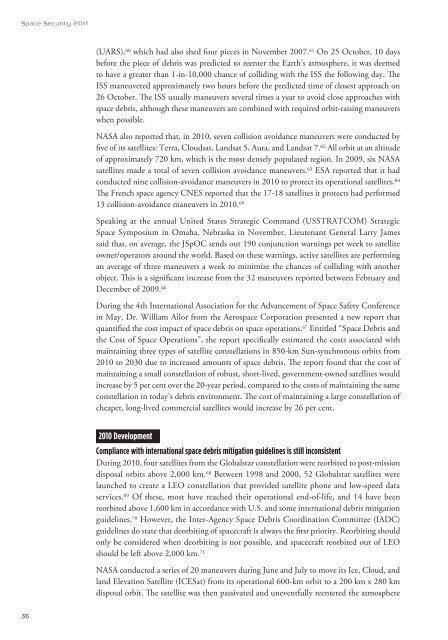Space Security Index
Space Security Index
Space Security Index
You also want an ePaper? Increase the reach of your titles
YUMPU automatically turns print PDFs into web optimized ePapers that Google loves.
<strong>Space</strong> <strong>Security</strong> 2011<br />
36<br />
(UARS), 60 which had also shed four pieces in November 2007. 61 On 25 October, 10 days<br />
before the piece of debris was predicted to reenter the Earth’s atmosphere, it was deemed<br />
to have a greater than 1-in-10,000 chance of colliding with the ISS the following day. e<br />
ISS maneuvered approximately two hours before the predicted time of closest approach on<br />
26 October. e ISS usually maneuvers several times a year to avoid close approaches with<br />
space debris, although these maneuvers are combined with required orbit-raising maneuvers<br />
when possible.<br />
NASA also reported that, in 2010, seven collision avoidance maneuvers were conducted by<br />
ve of its satellites: Terra, Cloudsat, Landsat 5, Aura, and Landsat 7. 62 All orbit at an altitude<br />
of approximately 720 km, which is the most densely populated region. In 2009, six NASA<br />
satellites made a total of seven collision avoidance maneuvers. 63 ESA reported that it had<br />
conducted nine collision-avoidance maneuvers in 2010 to protect its operational satellites. 64<br />
e French space agency CNES reported that the 17-18 satellites it protects had performed<br />
13 collision-avoidance maneuvers in 2010. 65<br />
Speaking at the annual United States Strategic Command (USSTRATCOM) Strategic<br />
<strong>Space</strong> Symposium in Omaha, Nebraska in November, Lieutenant General Larry James<br />
said that, on average, the JSpOC sends out 190 conjunction warnings per week to satellite<br />
owner/operators around the world. Based on these warnings, active satellites are performing<br />
an average of three maneuvers a week to minimize the chances of colliding with another<br />
object. is is a signicant increase from the 32 maneuvers reported between February and<br />
December of 2009. 66<br />
During the 4th International Association for the Advancement of <strong>Space</strong> Safety Conference<br />
in May, Dr. William Ailor from the Aerospace Corporation presented a new report that<br />
quantied the cost impact of space debris on space operations. 67 Entitled “<strong>Space</strong> Debris and<br />
the Cost of <strong>Space</strong> Operations”, the report specically estimated the costs associated with<br />
maintaining three types of satellite constellations in 850-km Sun-synchronous orbits from<br />
2010 to 2030 due to increased amounts of space debris. e report found that the cost of<br />
maintaining a small constellation of robust, short-lived, government-owned satellites would<br />
increase by 5 per cent over the 20-year period, compared to the costs of maintaining the same<br />
constellation in today’s debris environment. e cost of maintaining a large constellation of<br />
cheaper, long-lived commercial satellites would increase by 26 per cent.<br />
2010 Development<br />
Compliance with international space debris mitigation guidelines is still inconsistent<br />
During 2010, four satellites from the Globalstar constellation were reorbited to post-mission<br />
disposal orbits above 2,000 km. 68 Between 1998 and 2000, 52 Globalstar satellites were<br />
launched to create a LEO constellation that provided satellite phone and low-speed data<br />
services. 69 Of these, most have reached their operational end-of-life, and 14 have been<br />
reorbited above 1,600 km in accordance with U.S. and some international debris mitigation<br />
guidelines. 70 However, the Inter-Agency <strong>Space</strong> Debris Coordination Committee (IADC)<br />
guidelines do state that deorbiting of spacecraft is always the rst priority. Reorbiting should<br />
only be considered when deorbiting is not possible, and spacecraft reorbited out of LEO<br />
should be left above 2,000 km. 71<br />
NASA conducted a series of 20 maneuvers during June and July to move its Ice, Cloud, and<br />
land Elevation Satellite (ICESat) from its operational 600-km orbit to a 200 km x 280 km<br />
disposal orbit. e satellite was then passivated and uneventfully reentered the atmosphere

















